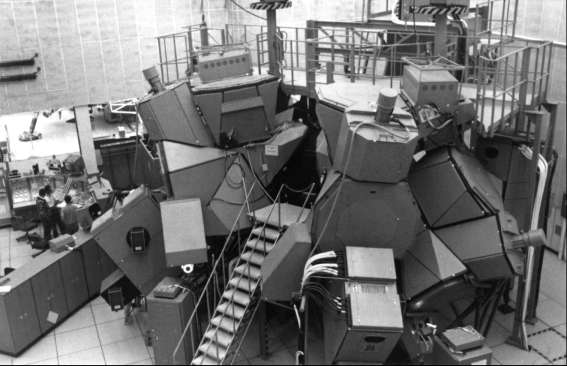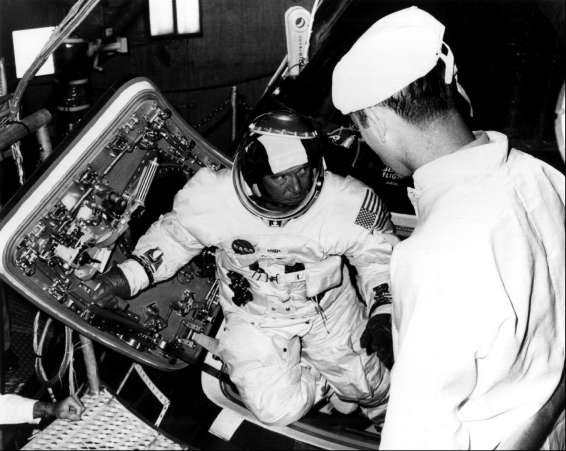
Apollo Astronauts at KSC
Before the end of February 1968, 18 Apollo astronauts had gone through exercises in the flight crew training building at Kennedy Space Center. This included both prime and backup crews for the first two manned Apollo missions. They used the mission simulators and the emergency egress trainer and were schooled on functional and operational aspects of the spacecraft.25
The saga of the astronaut as a superman had begun and ended with the first seven astronauts, not from their doing, but because the public demanded a space legend. With the Apollo program, it became clear that the astronauts were exceptional men, but human. Even though selection policies tended to produce a type, the crews included diverse personalities. Some were informal and convivial, some serious and tending toward the scientific in outlook, some difficult to deal with, others easy of access. Some astronauts were extremely courteous to the ground crew, totally cooperative; others were not. Some challenged the test teams to softball games or went fishing with them, while others remained aloof. But while the men on the pad knew this, the nation as a whole and the world at large saw a different picture - a group of all-Americans who, if not supermen, had "nary a failing among 'em."
In an article in the Columbia Journalism Review a few years later, Robert Sherrod attributed this stereotype to an unfortunate contract that Life magazine had made to tell portions of the astronauts' stories.26 Sherrod told of a visit with a team of astronauts. He found them freely available. One cooked steaks for the Life crew. Another told of his Lincoln-like rise from obscurity. A third made flapjacks for his son's Cub Scout pack. "These three astronauts. . . . went sailing together," Sherrod wrote, "though they didn't really like each other very much. . . . It took some time for the truth to sink in: these famous young men were doing handsprings for Life because they were being paid for it. . . . My story never came off, except as a picture story; the astronauts came out, as usual, deodorized, plasticized, and homogenized, without anybody quite intending it that way."27
In actuality they were distinct and interesting human beings, and, at times, major problems for the men who had to deal with them.28 One of the heroic astronauts, for instance, was extremely rough in his language with the men on the ground - so much so that one of his most respected colleagues called a meeting of the ground crew to apologize for the man's conduct. One member of the launch team thought the tantrums deliberately contrived for two purposes: to get maximum efficiency out of the ground crew and to release personal tension. He said: "I would trust that astronaut to function perfectly in any tense situation. There is nothing I feel he couldn't do." The majority, however, agreed with their pad partner who remarked after listening to a recording of one outburst: "I hope they burn that tape."
The veteran astronauts were able to get one of their favorite pad men of Mercury and Gemini days, Gunter Wendt, transferred to Apollo. Gunter, a former Luftwaffe flight engineer, had emigrated to Missouri, where his father lived, after World War II. He had worked as a mechanic until he gained his citizenship papers and then joined McDonnell Aircraft Corporation. Sent to Florida, he had served on every spacecraft close-out crew from the launch of the monkey "Ham."29 Wendt had a commanding way, a heavy accent, and a wiry frame - all of which brought him the nickname among the astronauts of "Der Fuehrer of the Pad."30 The entire country was to hear his name in a few weeks. When Gunter looked in the window to make his final check of the Apollo 7 spacecraft, Wally Schirra quipped: "The next face you will see on your television screen is that of Gunter Wendt." Gunter retorted: "The next face you fellows better see is that of a frogman - or you're in trouble." Shortly after liftoff, Schirra asked Eisele what he saw out the window of the spacecraft. Eisele recalled the incident on the pad. As he looked out the window at endless space, he imitated Gunter's accent with words that went out to the television and radio audience: "I vunder vere Gunter vendt." This was to become the title of a chapter in a book of reminiscences by astronauts and their wives a few years later.31

Spacecraft simulator in the flight-crew training building.

Walter M. Schirra emerging from the spacecraft in an altitude chamber of the operations and checkout building, July 1968. Escape training was in progress.
Long before he "vundered vere Gunter vendt," Donn Eisele and his fellow crewmen of Apollo 7, Walter Schirra and Walter Cunningham, had gone through almost endless practice flights in the Apollo command module and lunar module simulators in the flight crew training building. Houston provided the management and operational personnel and KSC the facility support. After a series of lectures, the astronauts entered the simulators to practice all types of docking and rendezvous maneuvers, mission plans, malfunctions, and other situations that the pre-programmed computers threw at them. Gradually simulator work took precedence over briefings, and the astronauts concentrated on specific procedures for rendezvous and reentry.32
Each simulator consisted of an instructor's station, crew station, computer complex, and projectors to simulate stages of a flight. Engineers served as instructors, instruments keeping them informed at all times of what the pilot was doing. Through the windows, infinity optics equipment duplicated the scenery of space. The main components of a typical visual display for each window of the simulator included a 71-centimeter fiber-plastic celestial sphere embedded with 966 ball bearings of various sizes to represent the stars from the first through the fifth magnitudes, a mission-effects projector to provide earth and lunar scenes, and a rendezvous and docking projector which functioned as a realistic target during maneuvers.33
Two years later, when simulated moon landings had become commonplace for the astronauts and the simulator crews, they invited important guests to participate. Surprises were occasionally arranged for special guests. When French President Georges Pompidou moved the module toward the moon, he found the Eiffel Tower in the Sea of Tranquility. Another time, Chancellor Willy Brandt of the Federal Republic of West Germany landed the simulator on a Volkswagen symbol.34
While the astronauts continued their repetitious exercises in the simulators, crews prepared two altitude chambers in the manned spacecraft operations building, adjacent to the flight crew training building, to test the Apollo spacecraft before its first manned flight. One chamber would serve the command and service modules, the other the lunar module. The program called for manned sea-level tests of the command-service module with astronauts on board, an unmanned altitude test, and two manned altitude tests, one with Schirra's prime crew and one with the backup crew of Thomas Stafford, John Young, and Eugene Cernan. These tests were principally designed to prove the machines at very low pressures. Mercury and Gemini flights had already demonstrated man's capabilities.
During the final 90 days prior to their flight, the astronauts lived on a relatively permanent basis in crew headquarters on the fourth floor of the manned spacecraft operations building. From here, they could "big brother" their flight hardware as each system went through its tests. The quarters consisted of three 3-man apartments, a small gymnasium, a lounge, and a kitchen, as well as a small but fully equipped medical clinic.
| Next |